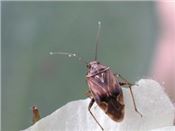Thinking About Plant Bugs In Cotton

DR. SCOTT STEWART
JACKSON, TENN.
It seems inevitable that cotton acres will drop in 2015, perhaps to a record low. I believe the number one factor causing increased plant bug pressure is reduced cotton acres, concentrating similar numbers of plant bugs in fewer acres. Thus, I suspect tarnished plant bugs will continue to be a major factor in cotton. Plant bugs are an important but manageable problem. Below are a few bullet points to think about in advance of planting.
My counterparts in Mississippi recently wrote a good article, and there is a link to more detailed best management practices within this article.
Best Management Practices for Tarnished Plant Bug
By Jeff Gore, Angus Catchot, and Don Cook, Mississippi State University, March 5th, 2015
Plant early and mostly with early maturing varieties. Not only does this help avoid late season problems, but it gives the crop a chance to recover if injury occurs.
Do not over-fertilize or irrigate. For much the same reason as above. These practices can unnecessarily delay maturity.
Arrange or group fields to avoid edge effects. Where possible, don’t plant you cotton within a sea of corn.
Scout!!! The biggest mistakes are usually when somebody didn’t even know they had a problem until it was too late. You should have a ‘professional’ scouting program in place before planting. The second biggest mistakes come from delaying an application or choosing the wrong insecticide.
Choose the right insecticides and apply them to assure adequate coverage. There are a lot of good insecticide options that should be used in a logical program. I have addressed this topic many times in past articles (and will again in the future). Products like Centric, Imidacloprid, Orthene, Transform, Bidrin and Diamond are the backbone of a good plant bug management program.
Plan on making consecutive applications on a 4-5 day interval when battling heavy pressure. A single application is never as good as two applications (unless you are making two applications with a crappy product).
Terminate plant bug applications no later than NAWF5 + 300-350 DD60s. ∆
DR. SCOTT STEWART: IPM Extension Specialist, University of Tennessee